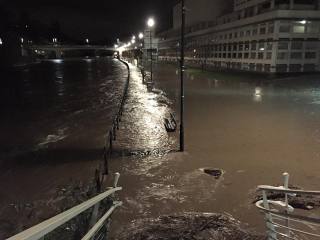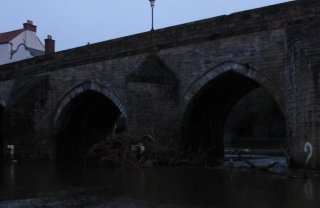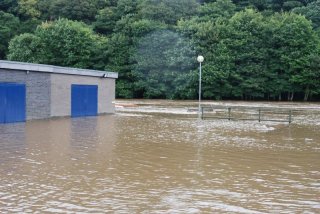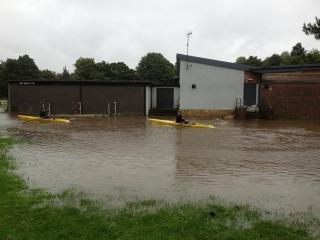Sustained high temperatures and unprecedented rainfall during December have taken their toll on the River Wear with flood defences being put into place twice within 3 weeks, the Environment Agency recording levels of around 2.90 metres on December 6th and again on the 26th, compared to the normal river level of around 0.50 metres.
This meant club staff being summoned in response to Environment Agency flood alerts to install the flood defences and move vulnerable equipment at 3am on the 6th and again on Boxing Day. After Storm Desmond on the 6th and Storm Eva on the 26th fears over the arrival of Storm Frank on December 30th proved unfounded. On each occasion the rising water stopped just short of the building and the defences weren’t put to the test. Nevertheless the decision was taken to leave the sandbags in situ and keep the club closed over the festive season with all buildings sealed and the drainage system disconnected between Boxing Day and New Year’s Eve to guard against possible further flooding. Our thoughts are with those across the north of England and south of Scotland who have suffered worse than us.
As a result of the aftermath Elvet Bridge has remained blocked by debris throughout December despite valiant attempts to remove trees from its arches.
Durham’s topography means that flooding remains a constant problem, although recent disruption falls far short of the highest recorded instance on July 18th 2009 when the river level reached 3.71 metres. Other notable heights in excess of 3m occurred on September 25th 2012 and May 18th 2013.
Since the inception of the Environment Agency in 1997 regulation of waterways has become more stringently regulated and subject to ever increasing legislation. The European Water Framework Directive (EWFD) was adopted in 2000 to manage the water environment throughout Europe, ensuring that waterways are maintained in a good ecological state. In compliance with this the Environment Agency has a management plan for waterways within specific river catchment areas, with the River Wear falling into the Northumbria River Basin District.
The management plan focuses on numerous areas, including flood risk mitigation, and the Agency has been keen to receive feedback, via consultations, that can be used to modify the plan. Other aspects involve the clearance of obstructions caused by flood debris, and the dredging of the river, which has been a constant issue in recent years as the EWFD precludes dredging and imposes funding restrictions. Since 2010 the club has negotiated agreement allowing a certain amount of dredging to be carried out by moving gravel from one part of the river bed to another, but the silting problem remains. In an attempt to ensure the sport can continue to flourish a response to the latest Agency consultation pointed out that many rowing clubs are based on managed waterways on tidal rivers or lakes where obstruction and silting aren’t an issue. In addition it was suggested that rowing should be included as one of the activities listed under the Agency’s Leisure/Tourism category, thereby qualifying the Wear as a managed waterway.
With the storms abating for the time being the club will reopen in time for the New Year’s Eve party to go ahead starting at 8pm. The New Year scratch regatta planned for January 3rd 2016 will be dependent on conditions.
All the Best for 2016.





